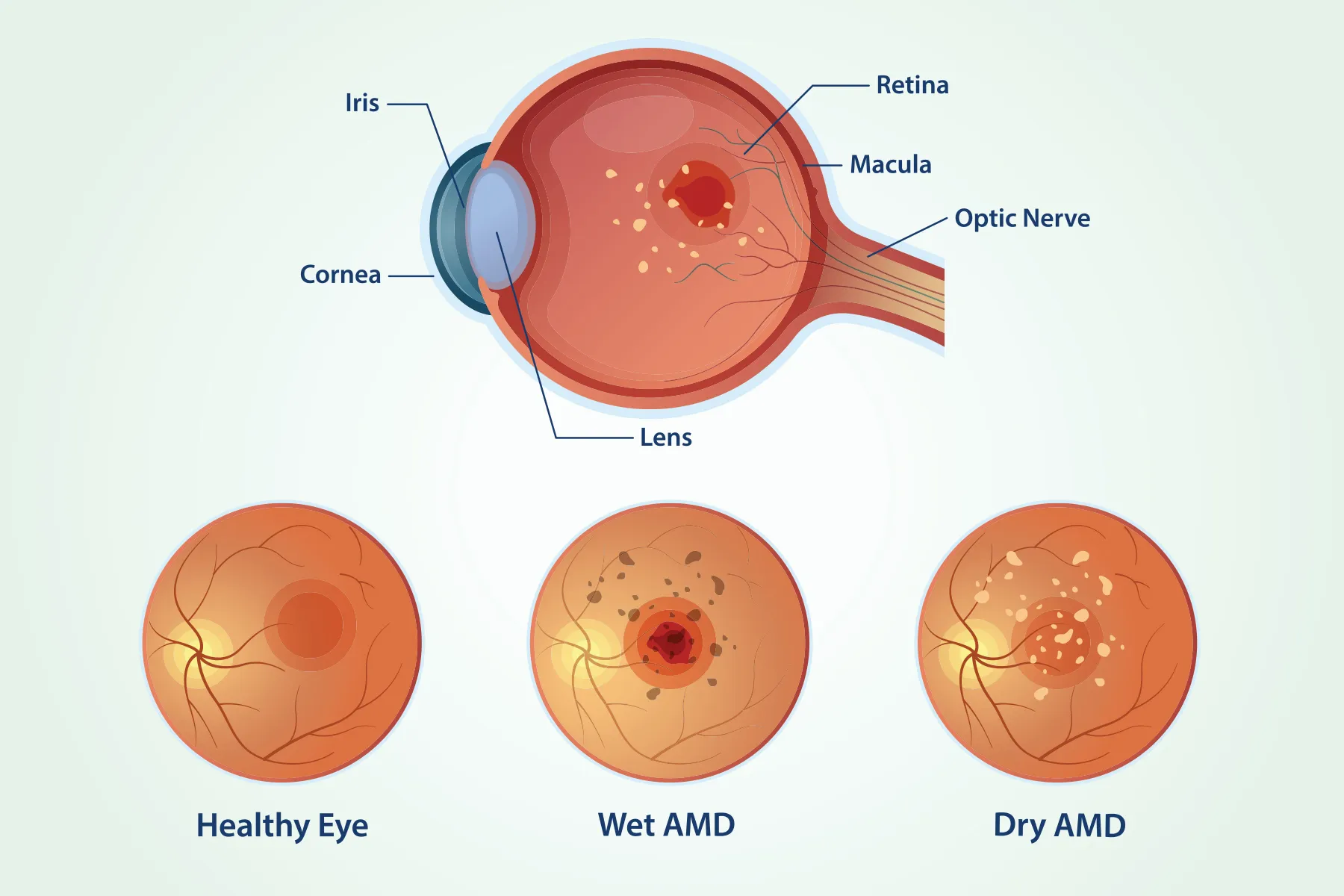
Our eyesight is incredibly precious. It allows us to see the world. Age can bring many changes. Some are normal, like reading glasses. Others are more serious concerns. Age-related macular degeneration (AMD) is one. It affects central vision. This makes daily tasks hard. Understanding this condition is key. It helps in early detection. This can preserve remaining sight.
The Macula’s Important Role
The macula is part of the eye. It’s a small, crucial area. Located in the retina’s center. It provides sharp, central vision. This allows us to see fine details. Reading, recognizing faces, driving. All depend on a healthy macula. It processes direct light. Damage here affects daily life. AMD specifically targets this area. Its function deteriorates over time.
Dry AMD: Gradual Progression
This is the most common form. About 85-90% of AMD cases. It progresses slowly over years. Tiny yellow deposits appear. Doctors call these drusen. They accumulate under the retina. These deposits interfere with function. Macular cells slowly break down. Vision loss is gradual. Often, one eye is affected first. The other eye compensates for a while. Many people don’t notice early.
Wet AMD: Rapid Vision Loss
This form is less common. But it’s much more severe. It causes rapid vision loss. Abnormal blood vessels grow. They form under the retina. These new vessels are fragile. They leak blood and fluid. This damages the macula quickly. Vision distortion occurs suddenly. Straight lines appear wavy. A central blind spot develops. Prompt treatment is crucial. Without it, severe loss happens fast.
Common Risk Factors
Age is the primary risk. AMD mostly affects older adults. Genetics also play a big role. A family history increases risk. Smoking is a major contributor. It significantly raises the chances. Obesity can increase progression. High blood pressure is a factor. A diet low in certain nutrients. Prolonged sun exposure might contribute. Being Caucasian also raises risk. Understanding risks helps prevention.
Symptoms to Watch For
Early AMD might have no symptoms. Regular eye exams are vital. As it progresses, changes appear. Blurred central vision is common. It might affect one eye first. Difficulty recognizing faces. Reading becomes very challenging. Straight lines appear wavy or bent. This is metamorphopsia. Dark, blurry, or blank spots. These appear in central vision. Colors may seem less vibrant. Reduced light sensitivity also.
Diagnosis Through Eye Exams
An ophthalmologist diagnoses AMD. They perform a comprehensive exam. A dilated eye exam is crucial. The doctor checks the retina. They look for drusen and changes. An Amsler grid test is simple. You cover one eye and look. Straight lines appear wavy. This suggests macular damage. Optical Coherence Tomography (OCT) is used. It creates detailed retinal images. Fluorescein angiography also helps. It tracks blood flow in the eye.
Treatment for Dry AMD
No cure exists for dry AMD. But progression can be slowed. Special vitamin supplements help. These are called AREDS2 formula. They contain antioxidants and zinc. They reduce progression in some cases. Your doctor will advise their use. Regular monitoring is essential. Low vision aids can help. Magnifiers assist with reading. Brighter lighting can improve visibility. Protecting eyes from sun is wise.
Treatments for Wet AMD
Wet AMD requires urgent treatment. Injections are a primary therapy. Anti-VEGF drugs are injected. They block abnormal vessel growth. They also stop leakage effectively. Injections are given regularly. Frequency varies by patient. Some need monthly injections. Others less often. Photodynamic therapy is another option. It uses a light-activated drug. Laser photocoagulation is rare now. Early treatment saves vision.
Low Vision Rehabilitation
Vision loss impacts daily life. Low vision rehabilitation helps. Specialists teach coping strategies. They recommend adaptive devices. Magnifying glasses are often used. Telescopes help with distance. Special computer software assists. Large print materials are available. Lighting adjustments can improve sight. Learning new skills is empowering. This improves independence. It enhances quality of life.
The Importance of Diet
A healthy diet supports eyes. Foods rich in antioxidants help. Leafy green vegetables are great. Spinach, kale, collard greens. They contain lutein and zeaxanthin. These protect the macula. Orange and yellow fruits also help. Fish rich in omega-3 fatty acids. Salmon, tuna, and mackerel are good. These support overall eye health. A balanced diet is preventive.
Lifestyle Adjustments
Quitting smoking is vital. It’s the most important step. Manage high blood pressure. Control blood sugar levels. Maintain a healthy weight always. Protect your eyes from UV light. Wear sunglasses outdoors. Choose ones that block 100% UV. Exercise regularly for overall health. These simple steps reduce risk. They support your vision longevity.
Ongoing Research Efforts
Scientists are actively researching. They seek new treatments for AMD. Gene therapy is a promising area. Stem cell research also continues. New drug targets are explored. Better diagnostic tools are developing. The goal is to prevent vision loss. Also, to restore lost sight. Hope for future breakthroughs exists. Research brings new understanding.
Coping and Support
Living with AMD can be hard. Vision loss is a major challenge. Emotional support is very important. Connect with family and friends. Join support groups for patients. Sharing experiences helps greatly. Organizations offer valuable resources. They provide information and guidance. Don’t face it alone. Seek help when you need it.
Regular Eye Care is Crucial
Don’t wait for symptoms to appear. Regular dilated eye exams are key. Especially if you are over 50. Or have risk factors present. Early detection changes outcomes. It allows for timely intervention. This can preserve your precious sight. Be proactive about eye health.
